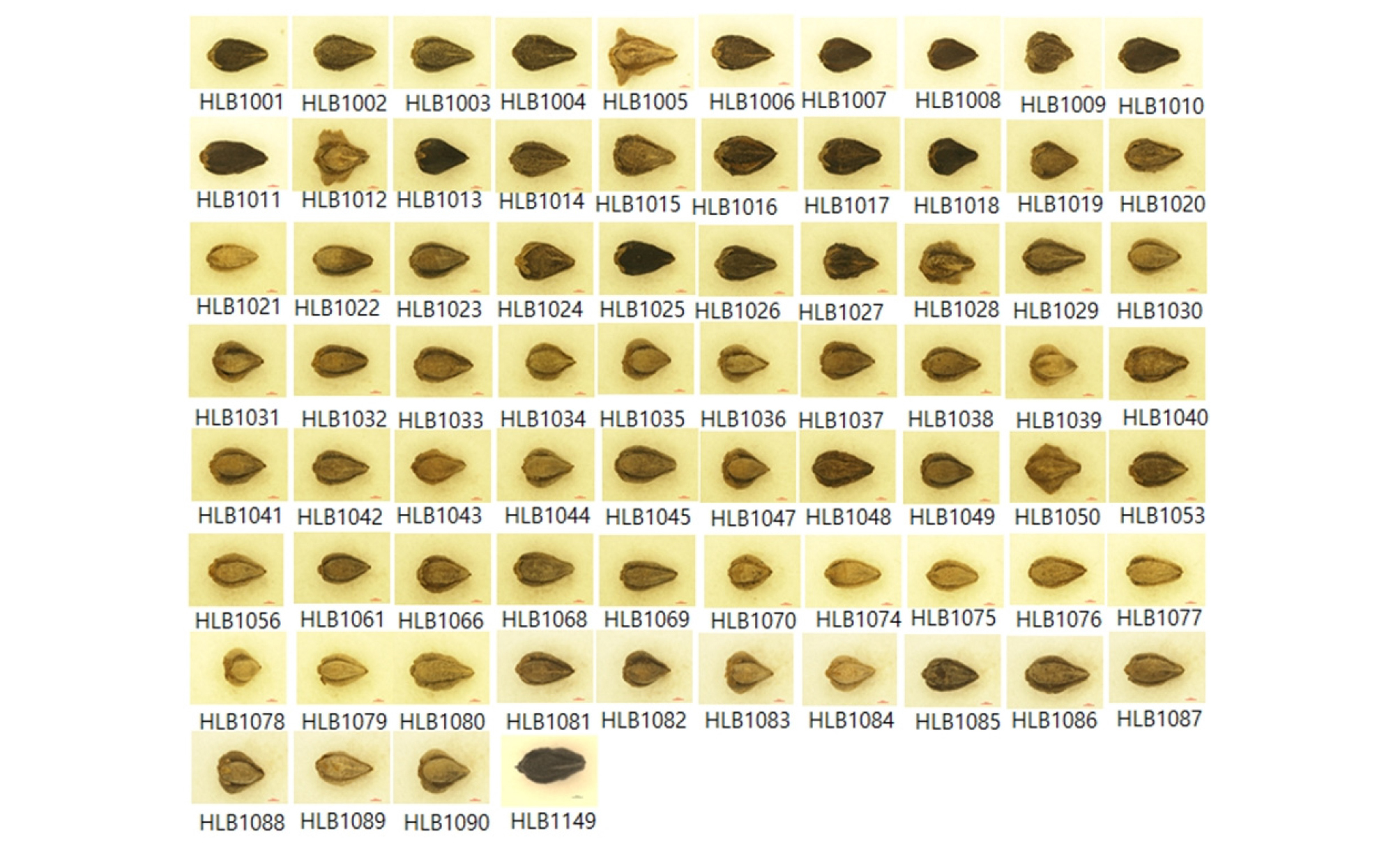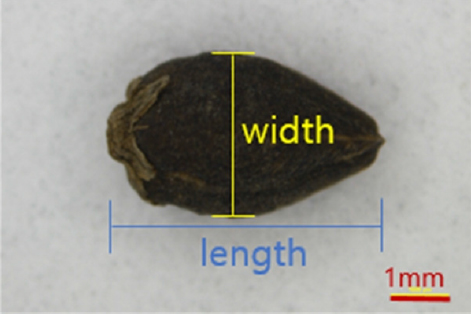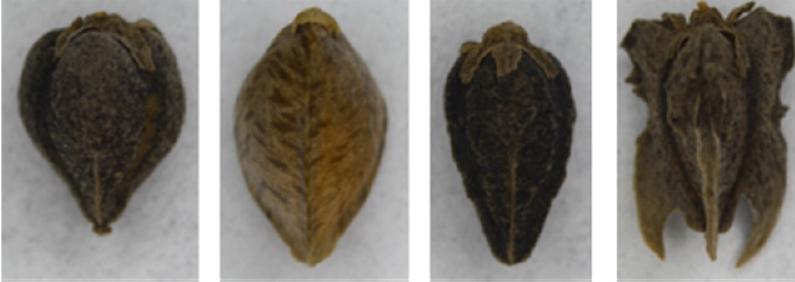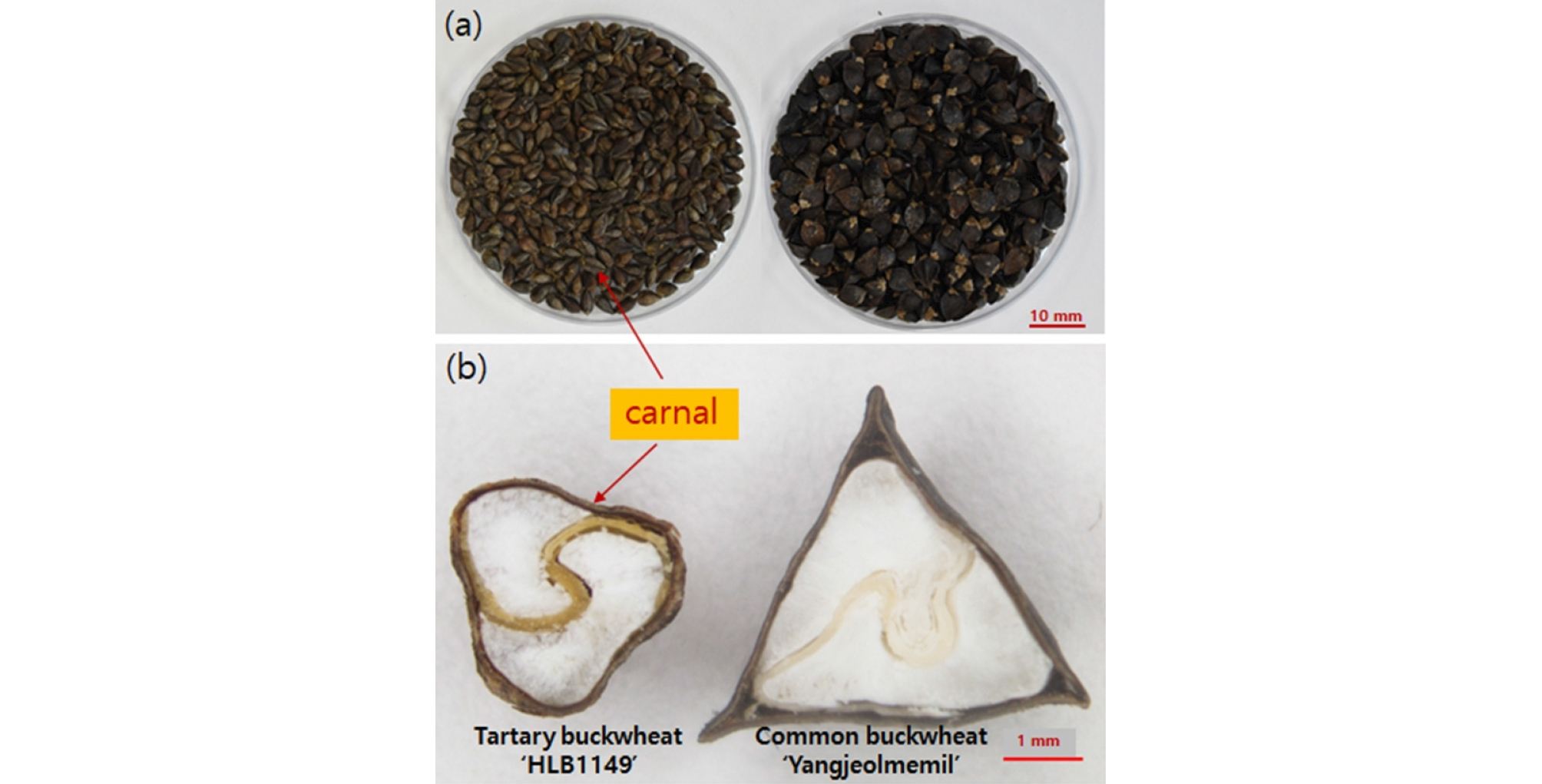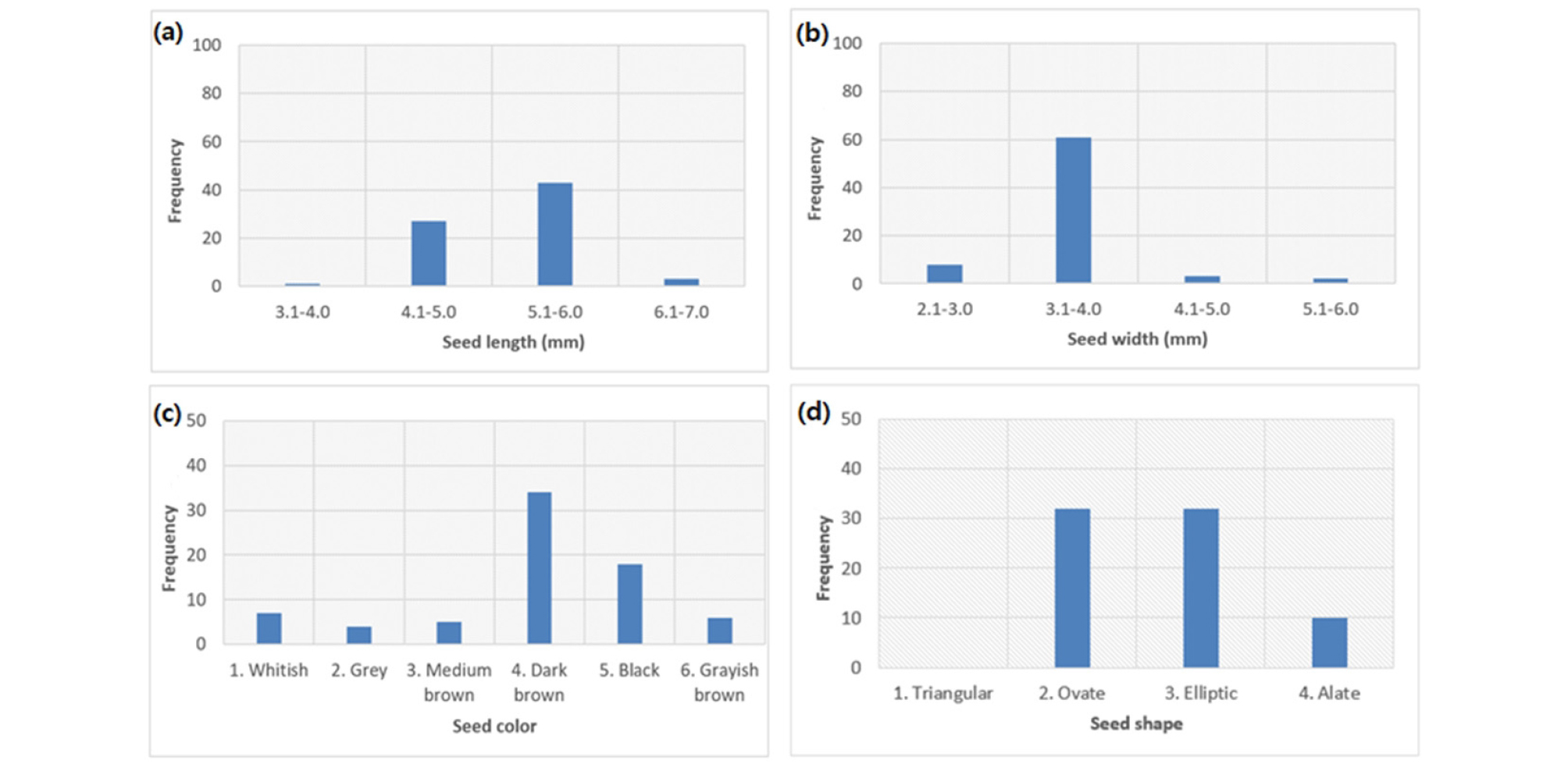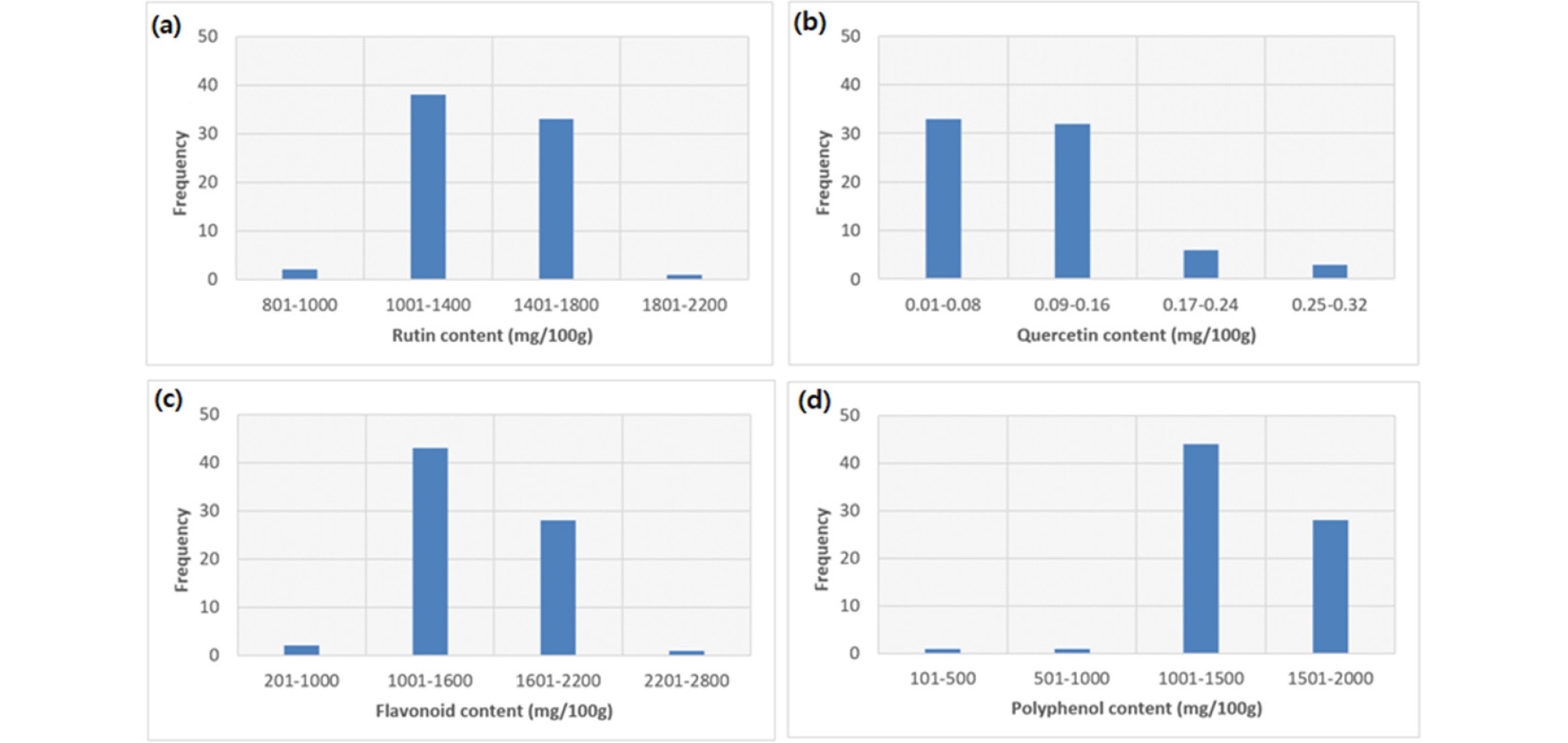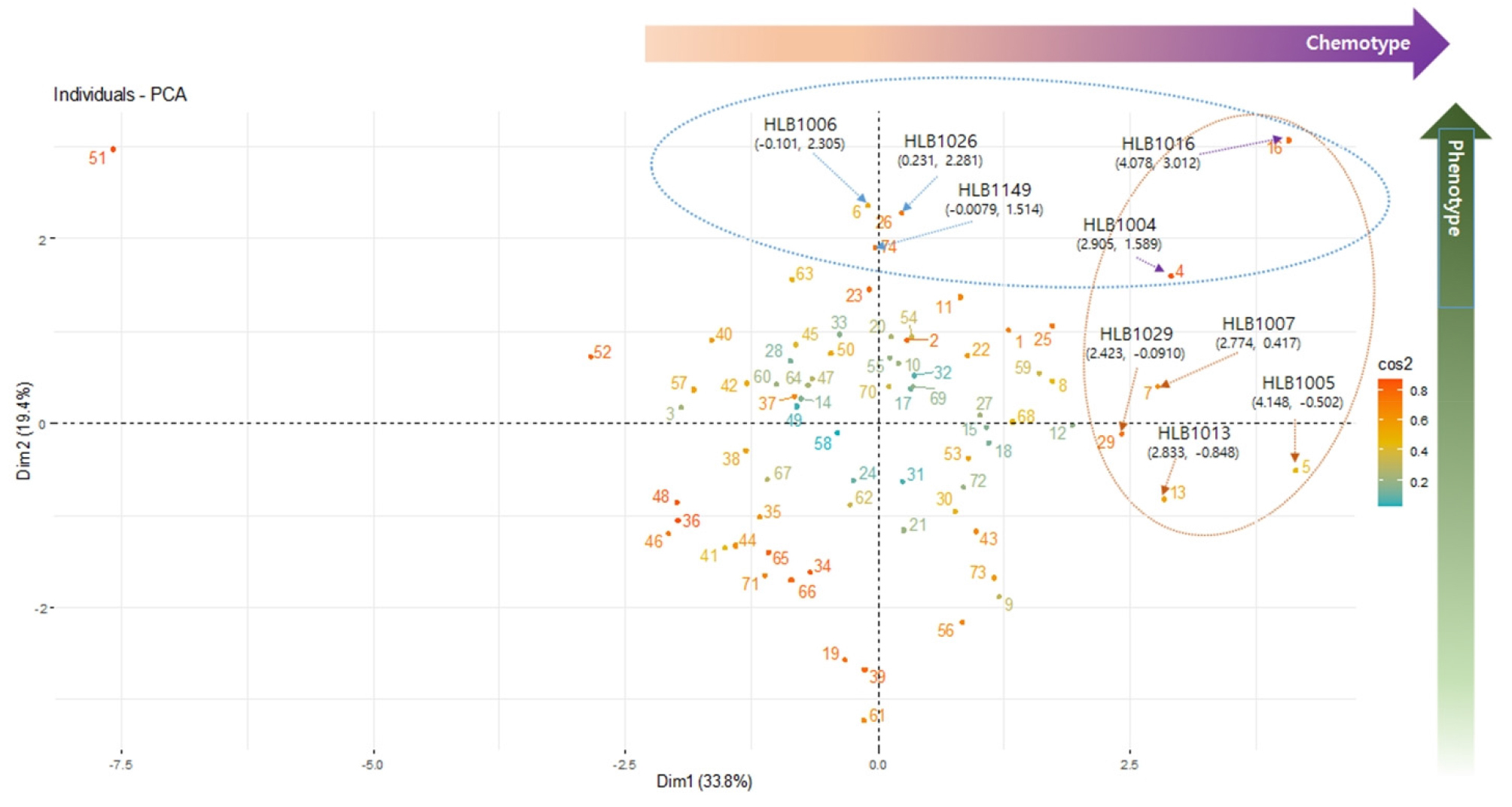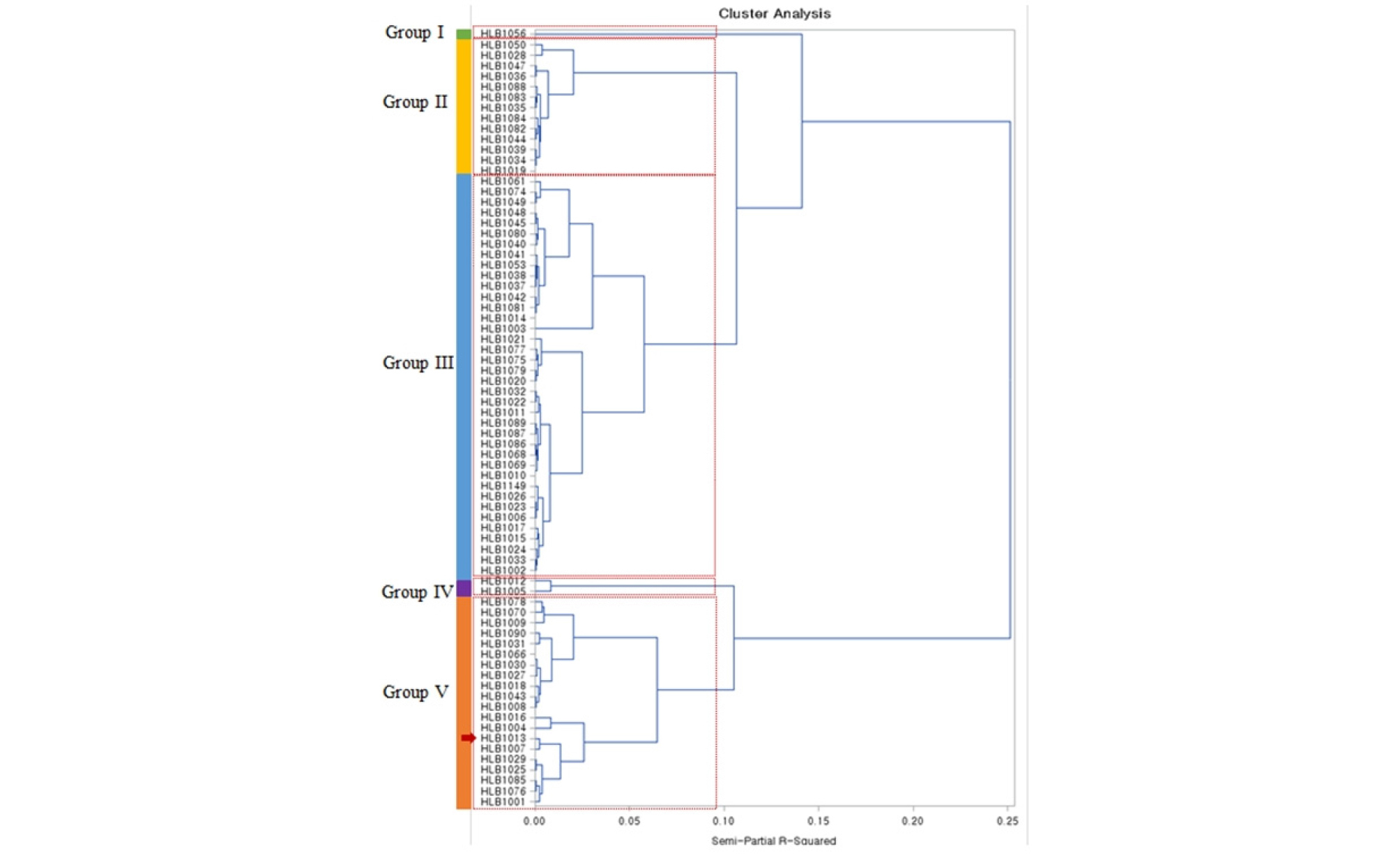서 언
재료 및 방법
실험 재료 및 재배 조건
종자의 표현형(phenotype) 조사
종자의 유용성분(chemotype) 분석
통계분석
결과 및 고찰
종자의 형태적 특성 평가
종자의 유용성분 분석
주성분분석(Principle component analysis)
군집분석(Cluster analysis)
유망 자원 선발
적 요
서 언
쓴메밀(Fagopyrum tataricum Gaertner)은 일반메밀(Fagopyrum esculentum Moench)과 함께 식물분류학적으로 마디풀과, 메밀속(Fagopyrum)에 속하는 일년생 쌍떡잎식물이다(Ahmed et al., 2013; Chauhan et al., 2010; Koyama et al., 2013). 지금까지 메밀속에는 20종 이상의 식물이 보고되었으나 전세계적으로 일반메밀과 쓴메밀 2종이 주로 재배된다(Kreft et al., 1994). 메밀(buckwheat)은 국명 및 영명 모두 밀(wheat)이라는 단어가 포함되지만 밀과는 분류학적 관계가 없다(Rauf et al., 2019). 메밀 종자는 수과(achene)에 속하지만 종자의 용도가 곡물과 비슷해 유사 곡물(pseudo-cereal)로 간주되고 있다(Joshi and Rana, 1995).
쓴메밀은 중국 윈난성, 쓰촨성, 티베트, 파키스탄 북동부 지역에서 야생종과 재배종이 함께 발견되었다(Tsuji and Ohnishi, 2001). 최근에는 중국 남서부 산악지대, 인도 북부, 부탄, 네팔, 인도, 일본, 우리나라를 포함한 아시아 뿐만 아니라 러시아, 캐나다, 체코, 슬로베니아, 스웨덴 등 전 세계적으로 재배가 이루어지고 있다(Campbell, 1997; Kreft et al., 1994). 쓴메밀은 타식성인 일반메밀과는 달리 자식성이며, 종자 크기는 일반메밀에 비해 작고, 가운데 보리처럼 홈이 있어 껍질을 벗기기가 어렵고, 쓴맛이 있는 특징이 있다(Bonafaccia et al., 2003; Fabjan et al., 2003; Holasova et al., 2002; Liu et al., 2008). 또한, 쓴메밀에는 메밀의 주요 건강기능성분인 rutin이 일반메밀에 비해 70-100배 이상 많이 함유되어 있고, 아미노산, 단백질, 지질, 섬유질, 미네랄, 비타민, flavonoid가 풍부하여 차 또는 식의약 소재로 활용성이 증가하고 있다(Chen et al., 2018; Huang et al., 2014; Jiang et al., 2007; Merendino et al., 2014; Nam et al., 2015; Wang et al., 2013).
최근 고기능성 식품소재에 대한 소비자의 욕구가 높아짐에 따라 기능성작물 또는 품종의 개발이 활발히 이루어지고 있으며, 이를 위한 첫 단계인 유전자원의 특성평가를 통한 유용자원 선발이 중요해지고 있다(Lee et al., 2020). 유전적 다양성을 기반으로 한 우수자원의 선발 및 품종화는 고기능성을 추구하는 소비 트렌드에 효과적으로 대응할 수 있는 수단이 될 수 있다(Ferguson, 2007; Hyun et al., 2018).
쓴메밀 유전자원에 대한 평가는 원산지가 위치한 아시아 국가에서 주로 수행되었다. 네팔 150개 재래종을 대상으로 종자의 형태적 특성을 비교하였을 때 종자색은 회색 또는 갈색이 많았다는 보고(Baniya et al., 1995)와 중국에서 재래종을 대상으로 종자크기를 조사하였을 때 천립중 기준으로 중립 종자의 비율이 가장 높았다고 한 연구(Keli, 1992)가 대표적이며, 우리나라에서는 메밀의 활용도를 높이기 위해 12개국 원산의 메밀 유전자원 100개를 대상으로 새싹에서 rutin이나 quercetin 함량이 높은 3개 유전자원을 보고하였다(Rauf et al., 2019).
다변량분석은 복잡한 형질 특성을 보이는 유전자원을 해석하고, 다양한 작물의 유전자원 평가에 효과적으로 활용하는데 유용하다(Khorasani et al., 2011; Kim et al., 2014; Nielsen and Munck, 2003). 적용 사례로는 홍화 자원의 지방산 조성 및 식물 형태적 특성 비교(Sung et al., 2011), 귀리 유전자원의 원산지별 농업적 특성 비교(Lee et al., 2019), 산초 및 초피의 화학형 분류(Chae et al., 2001), 옥수수 품종의 질적형질 비교(Chang et al., 2013), 벼 이삭과 수량 관련 형질 분석(Park et al., 2015), 딸기의 원예적 형질에 의한 품종 구분(Kim et al., 2009), 작약 품종별 향기 비교(Ahn et al., 2018) 등이 보고되었다.
우리나라는 100여점의 쓴메밀 유전자원을 보유하고 있으며(Kim and Kim, 2018), 이들 자원을 이용해 rutin 고함유 계통 육성 등 다양한 용도의 품종개발이 시도되고 있다. 하지만 품종육성의 기초가 되는 유전자원에 대한 평가 연구는 아직까지 미흡한 실정이다. 우수한 품종을 성공적으로 개발하기 위해서는 쓴메밀 유전자원을 대상으로 육종목표에 부합하는 형질특성을 구명하고 형질별로 유전자원을 분류 및 선발하여 육종프로그램에서 유용자원을 최대한 활용할 수 있게 하는 것이 중요하다.
따라서, 본 연구에서는 쓴메밀 74개 유전자원을 대상으로 종자특성과 유용성분의 함량 분포를 파악함으로써 자원의 특성 및 보존정보를 사용자에게 제공하는 데이터 베이스 시스템 구축을 위한 기초자료로 활용하고자 한다.
재료 및 방법
실험 재료 및 재배 조건
본 연구에는 농촌진흥청(RDA) 국립농업과학원 농업유전자원센터(RDA gene bank)에서 분양 받은 쓴메밀 유전자원 74종을 1개체 1계통법으로 3세대 고정한 자원을 사용하였다(Table 1, Fig. 1). 유전적으로 고정된 74종의 유전자원 종자를 원예용 상토가 담긴 갈색 플라스틱 화분(직경 9 ㎝)에 1화분당 2알씩 총 5개 화분에 파종하고 국립식량과학원 고령지농업연구소 온실(20±10℃)에서 재배하였다. 성숙종자를 수확한 다음 수분 13% 이하로 건조시킨 후 사용하였다.
Table 1.
List of 74 tartary buckwheat accessions used to study seed traits of phenotype and chemotype
종자의 표현형(phenotype) 조사
건조된 메밀 종자는 실험실에서 종자길이, 종자폭, 종자색, 종자모양을 ‘농업과학기술조사분석표’를 기준으로 평가하였다(Kim and Kim, 2018). 건전한 종자를 대상으로 해부현미경(Nikon SMZ800, Nikon Co., Tokyo, Japan) 10배 조건에서 사진을 촬영한 다음 소프트웨어(Nikon Application Suite Ver. 2.8.1 Software, Nikon Microsystems, Nikon Co., Japan)를 사용하여 종자길이와 종자폭을 측정하였다(Table 2, Fig. 2). 종자색은 1: 은백색(whitish), 2: 회색(grey), 3: 갈색(medium brown), 4: 흑갈색(dark brown), 5: 흑색(black), 6: 회갈색(grayish brown)으로 6종류로 구분하여 수치화 하였다. 종자모양은 1: 삼각형(triangular) 2: 달갈형(ovate), 3: 타원형(elliptic), 4: 유시형(alate)의 4종류로 구분하여 수치화하였다.
Table 2.
Measurement guidelines of seed morphological characteristics in tartary buckwheat germplasm
종자의 유용성분(chemotype) 분석
종자의 유용성분인 rutin, quercetin, flavonoid, polyphenol 함량을 분석하였다. 먼저 시료 50 g을 측정하여 -70℃의 초저온냉동고에 보관한 후 동결건조기에서 다시 건조하였다. 건조 종자를 분쇄기(Grinder SFM-555 SP, Shinil Co., Seoul, Korea)로 마쇄하고 그 분말을 실험에 사용하였다. 동결건조한 분말시료 1 g에 100배의 100% 메탄올을 첨가하고 속슬렛추출기(Soxhlet heater DH-43, Jisico Sci., Seoul, Korea)의 80℃ 항온수조에서 2시간 환류냉각추출(reflux extraction)하여 유용성분을 추출하였다. 추출물은 여과지(No. 6, Whatman, Maidstone, UK)로 감압여과한 후 볼륨 플라스크로 옮겨 추출용매로 100 mL 정용하였다. 추출 시료는 초고속액체크로마토그래프(Ultra Performance Liquid Chromatograph, UPLC) 분석을 위해 멤브레인 필터(PTFE 13 ㎜ 0.20 ㎛, PALL Life Sciences, Ann Arbor, MI, USA)로 다시 여과한 후 분석전까지 -20℃ 냉동고에 보관하였다.
Rutin과 quercetin 함량 분석은 Kim et al. (2017)의 방법에 따라 UPLC (Acquity UPLC I-Class, Waters Corporation, Milford, MA, USA) 시스템을 사용하였다. 칼럼은 Acquity UPLC CSH C18 (1.7 ㎛ particle size, 2.1 × 100 ㎜ length; Waters)을 사용하였으며, 시료 주입량은 1 μL, 칼럼 온도는 30℃, 샘플 온도는 20℃로 각각 조정하였다. 검출기는 UV Detector로 파장 259 ㎚에서 흡광도를 측정하였다. 이동상은 용매 A (1% Formic acid in water, v/v)와 용매 B (0.1% Formic acid in acetonitrile, v/v)를 농도 구배(gradient elution) 방식으로 수행하였으며, 유속은 0.25 mL/min으로 일정하게 흘려주었다. 이동상 농도 구배 방식은 용매 B를 처음 7%의 농도로 시작하여 2분에서 11분까지 17%, 11분에서 13분까지 25%로 증가시킨 후 19분까지 유지시켰다. 이 후 19분에서 21분까지 농도를 25%에서 7%로 감소시키고 23분까지 동일 농도로 안정화하였다. 표준물질인 rutin (Extrasynthese, Genay, France)과 quercetin (Extrasynthese, Genay, France)의 피크와 추출물 샘플의 각 피크(peak)는 머무름 시간(retention time, RT)을 비교하여 크로마토그램으로 나타냈으며, rutin과 quercetin의 RT는 각각 9.23와 18.51 분이었다. Rutin과 quercetin 함량(㎎/100 g, 동결건조한 종자 기준)은 피크 면적(peak area)으로 계산하였으며, 이를 rutin과 quercetin을 농도별로 분석하여 검량곡선을 작성하였다.
Flavonoid와 polyphenol 분석은 UV/VIS absorbance를 장착한 Multi-mode microplate reader (Cytation 5 cell imaging multimode reader, Biotek instruments Inc. Winooski, VT, USA)로 측정하였고, 분석결과는 각각 수치로 나타내고, 이미지로도 저장하였다. 총 flavonoid 함량은 96 well plate에 표준물질 및 샘플 추출물 50 μL를 넣고, 증류수 100 μL와 5% NaNO2 용액 15 μL를 넣은 다음, 5분 후 10% AlCl3․6H2O 용액 30 μL를 가하여 6분간 반응시켰다. 반응 후에 1 N NaOH 용액 100 μL를 첨가하고, 11분 후 반응액의 흡광도를 510 ㎚에서 측정하였다(Dewanto et al., 2002). 표준물질로는 rutin (Extrasynthese, Genay, France)을 사용하였으며, 농도별로 multi-mode microplate reader로 분석하여 검량곡선을 작성하고, 시료 100 g 당 ㎎ rutin equivalent (RE, dry weight basis)로 나타내었다. 총 polyphenol 함량은 Folin-Ciocalteu 방법으로 분석하였다(Dewanto et al., 2002; Folin and Denis, 1912). 96 well plate에 표준물질 및 추출물 50 μL를 넣고 2% Na2CO3 용액 200 μL를 가한 후 실온에서 3분간 반응시킨 다음 50% Folin-Ciocalteu reagent (Sigma-Aldrich) 20 μL를 첨가하였다. 30분 후, 반응액의 흡광도 값을 750 ㎚에서 측정하였다. 표준물질로는 gallic acid (Sigma-Aldrich)를 사용하여 농도별로 multi-mode microplate reader로 분석하여 검량곡선을 작성하고, 시료 100 g당 ㎎ gallic acid equivalent (GAE, dry weight basis)로 나타내었다.
통계분석
쓴메밀 유전자원의 종자특성과 주요성분에 대한 주성분분석(PCA; Principal Component Analysis) 및 군집분석(CA; Cluster Analysis)을 수행하였으며, 분석 프로그램으로 SAS (2019) ver. 9.4와 R studio Team (2019) ver. 3.6.1를 활용하였다.
주성분분석은 종자특성 및 주요 유용성분 데이터가 몇 개의 요인에 의해 영향을 받는지와 변수들 간의 기여도 정도를 분석하였으며, Kassambara and Mundt (2017)의 방법에 따라 R studio에서 ‘FactoMineR’ 라이브러리(library)를 호출하여 ‘ggplot2’을 적용하여 분석하였다. 주성분 분석은 상관계수 행렬의 고유벡터(eigenvector)를 제1주성분(PC1)부터 제7주성분(PC7)까지 나타냈으며, 각 주성분별 고유치(eigenvalue) 및 기여율(contribution)을 표로 나타내었다. 또한, 그림(biplot)으로 나타내고자 차원(Dimension) 축소하여, x축을 제1주성분(Dim1), y축을 제2주성분(Dim2)으로 표현하고, 우수 자원에 대해서는 가중치를 표기했다(Park et al., 2016).
군집분석은 표현형과 화학형 각각에 대한 자원간 연관성 정도를 R studio에서 ‘ComplexHeatmap’ 라이브러리(library)를 호출하여 heatmap으로 표현하였다. 또한, SAS 를 이용하여 주성분분석 결과 고유값이 1 이상의 값을 보이는 5개 형질을 대상으로 군집 평균 간의 거리를 각 군집의 개수로 나눈 후 제곱근을 구한 거리를 활용하는 워드법(Ward’s method)을 적용하였다.
결과 및 고찰
종자의 형태적 특성 평가
쓴메밀 종자의 형태학적 특성을 평가하고 그 결과를 다음과 같이 나타냈다(Table 3; Fig. 1). 쓴메밀 유전자원의 종자길이는 3.5에서 6.4 ㎜의 범위를 보였으며, 평균 5.2 ㎜이었다. 종자길이가 가장 긴 자원은 HLB1004으로 6.4 ㎜였으며, HLB1078이 3.5 ㎜로 가장 짧았다(Table 3; Fig. 3a). 종자폭은 평균 3.4 ㎜였으며, 2.7 ㎜ (HLB1021)에서 5.7 ㎜ (HLB1005)의 범위를 보였다(Table 3; Fig 3b). 종피색은 흑갈색이 45.9%(34개 자원)로 가장 비율이 높았으며, 그 다음으로 흑색이 24.3%(18개 자원), 은백색 9.5%(7개 자원), 회갈색 8.1%(6개 자원), 갈색 6.8%(5개 자원), 회색 5.4%(4개 자원) 순이었다(Table 3; Fig. 3c). 종자모양은 달걀형과 타원형이 각각 43.2%(32개 자원)의 비율을 보였으며, 날개가 붙어 있는 유시형의 경우는 13.5%(10개 자원), 일반메밀의 대표적인 삼각형 모양은 관찰되지 않았다(Table 3; Fig, 3d).
Table 3.
Variation of seed phenotype and chemotype in 74 tartary buckwheat germplasm
일반메밀의 종자크기가 양절메밀 길이 6.7 × 폭 4.5 ㎜, 대산메밀 5.6 × 3.6 ㎜, 다원 6.8 × 4.0 ㎜인 것을 고려할 때 (Kim and Kim, 2018), 쓴메밀 유전자원의 종자크기가 일반메밀보다 작은 것은 육안으로도 구별이 가능하였다(Fig. 2). Ambika et al. (2014)은 일반메밀의 큰 종자가 쓴메밀의 작은 종자보다 발아에 더 유리한 경향이 있다고 하였으므로 쓴메밀의 유전자원간 종자크기와 발아율의 관계는 앞으로 검토가 필요할 것으로 판단된다. 또한, 종자모양이 삼각형인 일반메밀과는 달리 쓴메밀은 달걀형이나 타원형의 종자 모양이 주를 이루고 있으며, 보리처럼 종자 가운데 홈(canal)이 있는 형태적 특성을 가지고 있어(Fig. 2), 가공시 껍질을 벗길 때 수율을 떨어뜨리는 요인으로 작용할 수 있다. 따라서, 이를 해결할 수 있는 품종개발 및 가공기술의 개발이 필요할 것으로 판단된다.
종자의 유용성분 분석
쓴메밀 유전자원의 유용성분 분포에 대한 연구결과는 Table 3과 Fig. 4에 나타냈다. 쓴메밀 유전자원의 rutin 함량은 877-1,921 ㎎/100 g DW의 범위였으며, 유전자원 대부분(97.3%)이 1,001 ㎎/100 g DW 이상으로 높았다(Table 3; Fig. 4a). Rutin 함량별 분포를 보면, 유전자원의 51.4% (38개 자원)가 1,001-1,400 ㎎/100 g DW, 44.6% (33개 자원)는 1,401-1,800㎎/100g DW, 1,801 ㎎/100 g DW 이상은 1.4% (1개 자원)이었다. 또한 유전자원의 quercetin 함량은 0.05-0.30 ㎎/100 g DW의 범위를 보였으며, 함량 범위별로는 0.01-0.08 ㎎/100 g DW이 44.6%(33개 자원), 0.09-0.16 ㎎/100 g DW는 43.2%(32개 자원), 0.17-0.24 ㎎/100 g DW은 8.1%(6개 자원)였다(Table 3; Fig. 4b). 평균 유용성분 함량은 rutin이 1,393 ㎎/100 g DW, quercetin는 0.10 ㎎/100 g으로 쓴메밀 종자에 가장 많이 함유되어 있는 주요 기능성 성분은 rutin으로 나타났다.
쓴메밀 유전자원의 평균 flavonoid 함량은 1,567 ㎎/100 g DW였으며, 함량 범위별로는 1,001-1,600 ㎎/100 g DW은 58.1%(43개 자원), 1,601-2,200 ㎎/100 g DW는 37.8%(20개 자원)의 분포를 보였다(Table 3; Fig. 4c). 또한, 평균 polyphenol 함량은 1,439 ㎎/100 g DW였으며, 유전자원의 59.5%(44개 자원)는 1,001-1,500 ㎎/100 g DW의 함량 범위를 보였고, 37.8%(28개 자원)는 1,501-2,000 ㎎/100 g DW의 범위를 나타냈다(Table 3: Fig. 4d).
Flavonoid는 화학적 구조에 따라 항산화 활성에서 차이를 보이는데, 특히, 탄소 환(C ring)의 3-OH 그룹은 flavonoid 항산화 작용에 중요한 역할을 한다고 하였다(Rice-Evans et al., 1996). Rutin, quercetin, quercitrin을 포함한 쓴메밀에 있는 주요 flavonoid는 모두 루티노스(rutinose), 포도당(glucose) 또는 람노스(rhamnose)에 의해 블록킹된 C ring에 3-OH 그룹을 가지고 있어 항산화 활성이 높다고 하였다(Rauf et al., 2019).
기존 연구에서 쓴메밀의 flavonoid 함량은 일반메밀보다 4-5배 많아(Li and Zhang, 2001; Liu et al., 2008), 항종양, 항염증, 당뇨병, 암, 심장병 예방에 더 효과적이라고 보고하였다(Chao et al., 2002; Hertog et al., 1995; Li et al., 2016). 따라서, 본 연구에서 도출된 쓴메밀 유전자원에 대한 유용성분 분석정보와 재료는 향후 식의약 소재 개발에 효과적으로 활용될 수 있을 것으로 기대된다.
Rauf et al. (2019)은 쓴메밀 유전자원이 일반메밀 자원보다 플라보노이드의 변이폭이 크다고 하였는데, 이는 rutin과 quercetin 함량 범위의 차이에서 기인한다고 했다. 또한, rutin 함량의 유전력(heritability)은 종자와 잎에서 각각 0.59와 0.25로 종자의 rutin 함량은 잎보다 환경조건에 영향을 덜 받는 형질이라고 하였다(Kitabayashi et al., 1995). 따라서, rutin 함량이 높은 HLB1013(1,921 ㎎/100 g DW)와 1,700 ㎎/100 g DW 이상의 HLB1004, HLB1005, HLB1007, HLB1009등의 유전자원은 rutin 고함유 품종개발에 유용하게 활용될 수 있을 것으로 판단된다.
주성분분석(Principle component analysis)
주성분분석은 변수들 간의 상관관계를 고려하여 서로 유사한 변수들끼리 묶어주는 통계 방법으로(Kim et al. 2014), 데이터가 몇 개의 요인에 의해 영향을 받는지와 변수들 간의 상호의존 정도를 해석하는데 매우 유용하다. 본 연구에서도 쓴메밀 유전자원 74개의 종자 표현형과 화학형 분석결과를 바탕으로 각 집합 내에 존재하는 데이터의 차이를 가장 잘 설명해 주는 요인을 구명하기 위해 주성분분석을 수행하였다.
주성분분석 결과, 제1주성분(PC1)은 고유치가 2.703으로, 전체 분산 중 33.79%를 설명하였다(Table 4). 제2주성분(PC2)은 1.553에 19.42%, 제3주성분(PC3)은 1.227에 15.34%, 제4주성분(PC4)은 0.902에 11.27%, 제5주성분(PC5)은 0.738에 9.22%, 제6주성분(PC6)은 0.487에 6.08%, 제7주성분(PC7)은 0.281에 3.51%를 설명하는 것으로 나타났다. 분석에 사용되는 최종 주성분 수는 고유값 1이상 또는 누적분산비율이 80% 이상의 조건에서 결정된다(Kim et al., 2016; RDA, 2003). 본 연구에서는 주성분의 고유값이 1 이상의 값을 보이는 제3주성분까지 전체 분산의 68.55%를 설명하는 것으로 나타났다. 제1주성분에는 rutin, flavonoid, polyphenol 등 화학형이 높은 비율을 보였으며, 제2 주성분에서는 종자 표현형인 종자길이, 제3주성분에서는 종자폭의 비중이 큰 것으로 분석되었다. 이러한 주성분분석 결과를 바탕으로 제1주성분은 종자화학형, 제2와 제3주성분은 종자표현형으로 나타냈다.
Table 4.
Eigenvalues and eigenvectors of tartary buckwheat germplasm for the diversity in seed phenotype and chemotype traits
또한, 종자의 표현형과 화학형의 주성분분석 결과(Fig. 5)에서도 가로축(종자화학형) 기준으로 보았을 때 오른쪽 영역에 위치한 flavonoid, polyphenol 및 rutin의 기여율이 높게 나타났으며, 세로축(종자표현형)을 기준으로는 위쪽 영역에 위치한 종자길이의 기여율이 높았다.
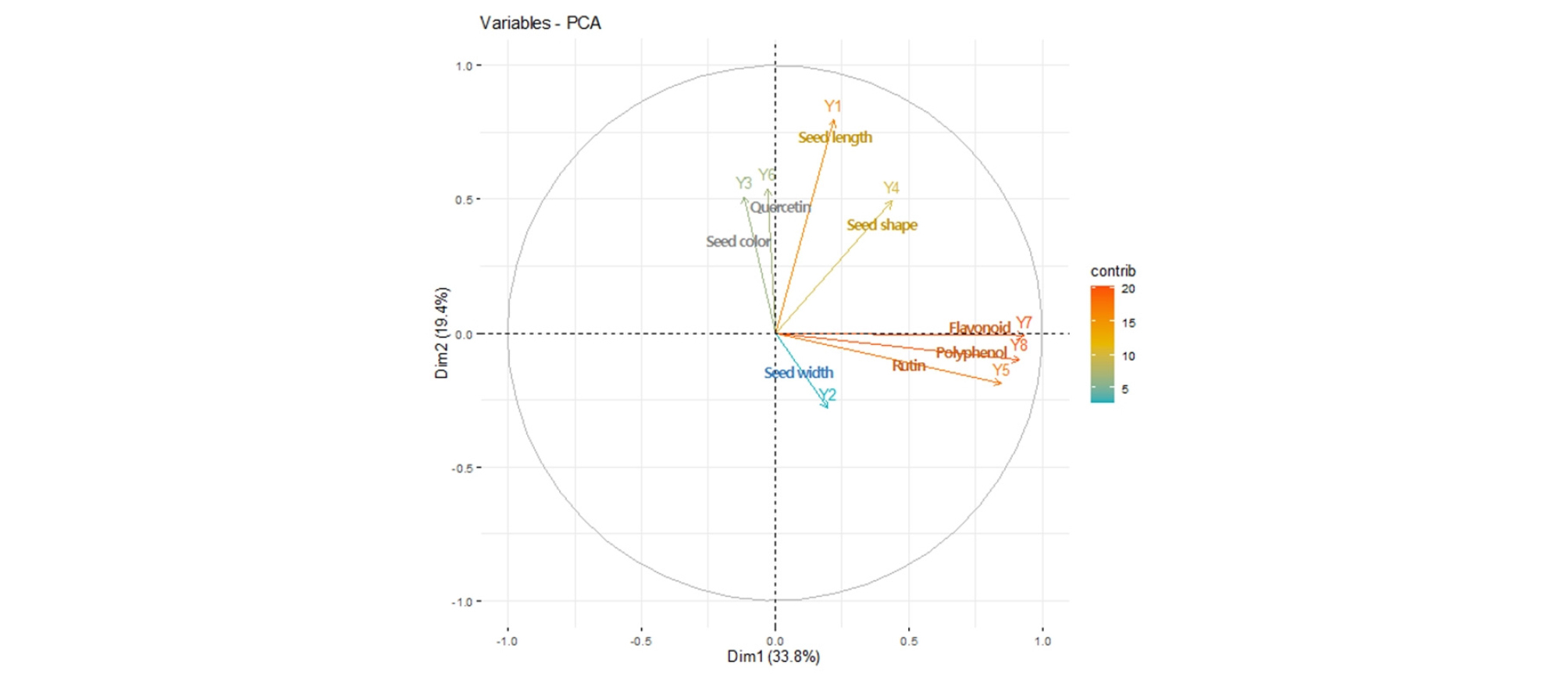
Fig. 5.
Relationship among traits in the principal component analysis on the eight phenotype and chemotype of tartary buckwheat germplasm. Dim1 and Dim2 refer to the first and second dimensions, respectively. Y1, Y2, Y3, Y4, Y5, Y6, Y7, and Y8 of 2 dimension graph indicate seed length, seed length, seed width, seed color, seed shape, rutin, quercetin, flavonoid, and polyphenol contents, respectively.
쓴메밀 유전자원의 주성분 점수에 따른 분석결과는 Fig. 6에 나타냈다. 제1 주성분인 종자화학형을 많이 포함하고 있어 기능성이 우수한 유전자원으로는 HLB1005, HLB 1016, HLB1004, HLB1013, HLB1007, HLB1029등 6개 자원이, 제2주성분인 종자표현형을 많이 포함하고 있어 종자특성이 우수한 유전자원으로는 HLB1016, HLB1006, HLB1026, HLB1149, HLB1004등 5개 자원이 선발되었다. 최종적으로 유용성분 함량이 높으면서 종자 특성이 우수한 HLB1016과 HLB1004로서 2개 자원을 선발하였다.
군집분석(Cluster analysis)
군집분석은 조사한 관찰치 중에서 유사한 것들을 몇몇 집단으로 묶어 각 그룹의 특성을 구명하는 방법으로 변수 전체의 구조에 대한 이해를 돕고 각 집단의 경향을 쉽게 파악하는데 사용되고 있다(Kim et al., 2014).
먼저 종자 표현형을 기준으로 한 heatmap 분석결과(Fig. 7)에서는 74개 유전자원이 4개의 군집으로 구분되었다. 제I군에는 종자길이가 가장 짧고, 대부분 은백색이 종자색의 특징을 가지는 7개 유전자원이, 제II군은 종자크기가 가장 크고, 유시형이 많이 분포하는 특징을 보이는 9개 자원이, 제III군은 종자크기가 작고, 특이하게도 종자모양이 모두 달갈형인 25개 자원이, 제IV군은 종자폭이 좁고, 종자모양이 타원형으로 가장 많은 33개 자원으로 군집을 형성 하는 것으로 나타났다. 종자화학형을 기준으로 한 heatmap 분석(Fig. 8)에서도, 종자표현형처럼 4개 의 군집으로 구분되었다. 제I군에는 rutin, flavonoid 및 polyphenol 함량이 가장 낮은 27개 자원이, 제II군은 제III군보다는 화학형 함량이 낮고, 제I군보다는 화학형 함량이 높은 rutin과 flavonoid 함량이 중간정도인 21개 자원이, 제III군은 rutin, flavonoid 및 polyphenol 함량이 높은 18 자원이, 제IV군은 특이하게도 quercetin 함량이 높은 8개 자원이 해당되었다. rutin 함량이 높은 자원들이 하나의 군집으로 분류된 것은 유사한 화학형이 유전적 유사도에 의해 영향을 받은 결과로 생각되며, 유전자원의 수집지역별 재배환경의 차이가 이러한 결과의 주된 원인일 것으로 추측된다.
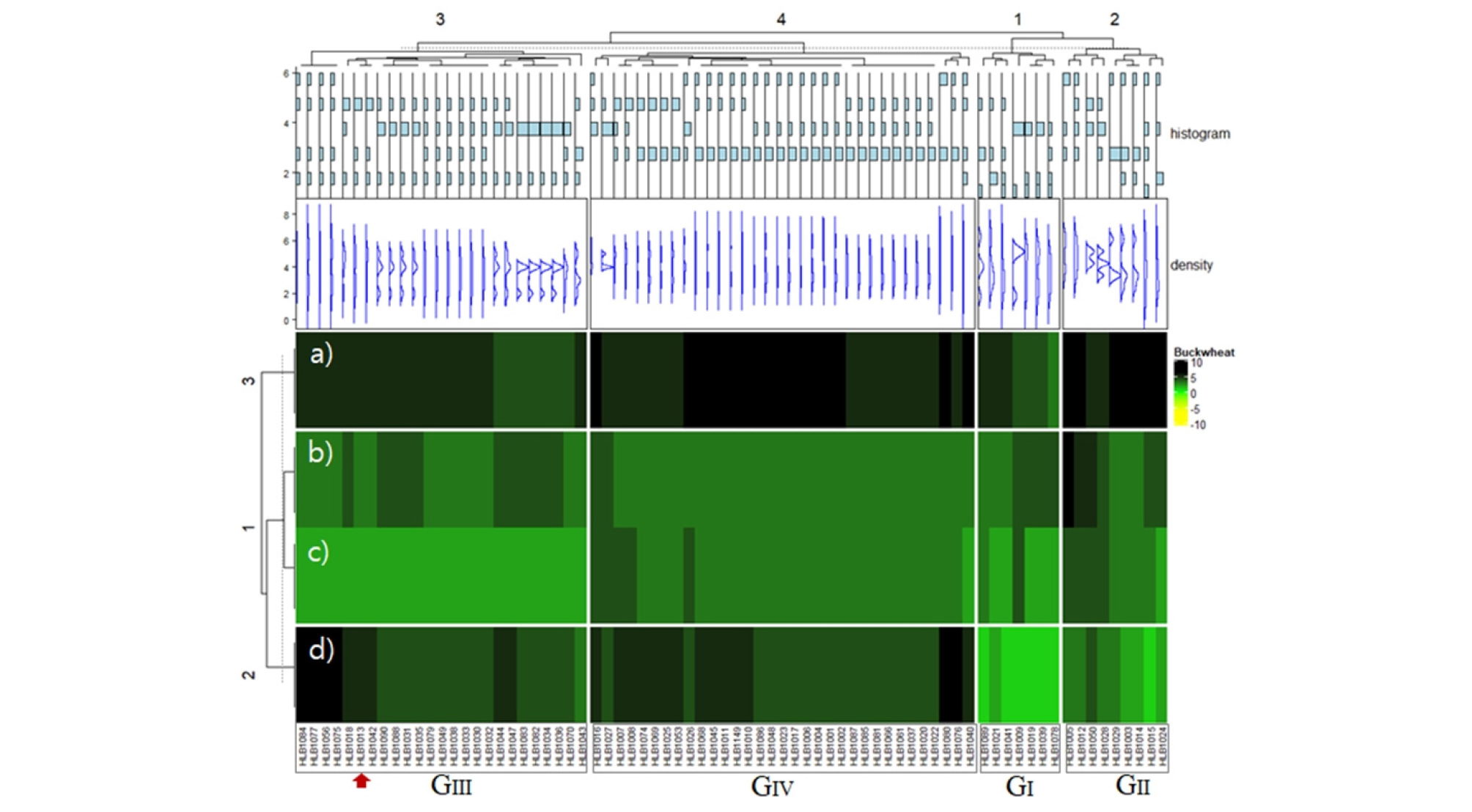
Fig. 7.
Heatmap representing differences in the phenotype of 74 tartary buckwheat germplasm. These data were standardized for phenotype of a) seed width, b) seed shape, c) seed length, and d) seed color. Yellow or Green indicates that the seed morphological value is increased or decreased, respectively. Red arrow indicates the highest rutin accession.
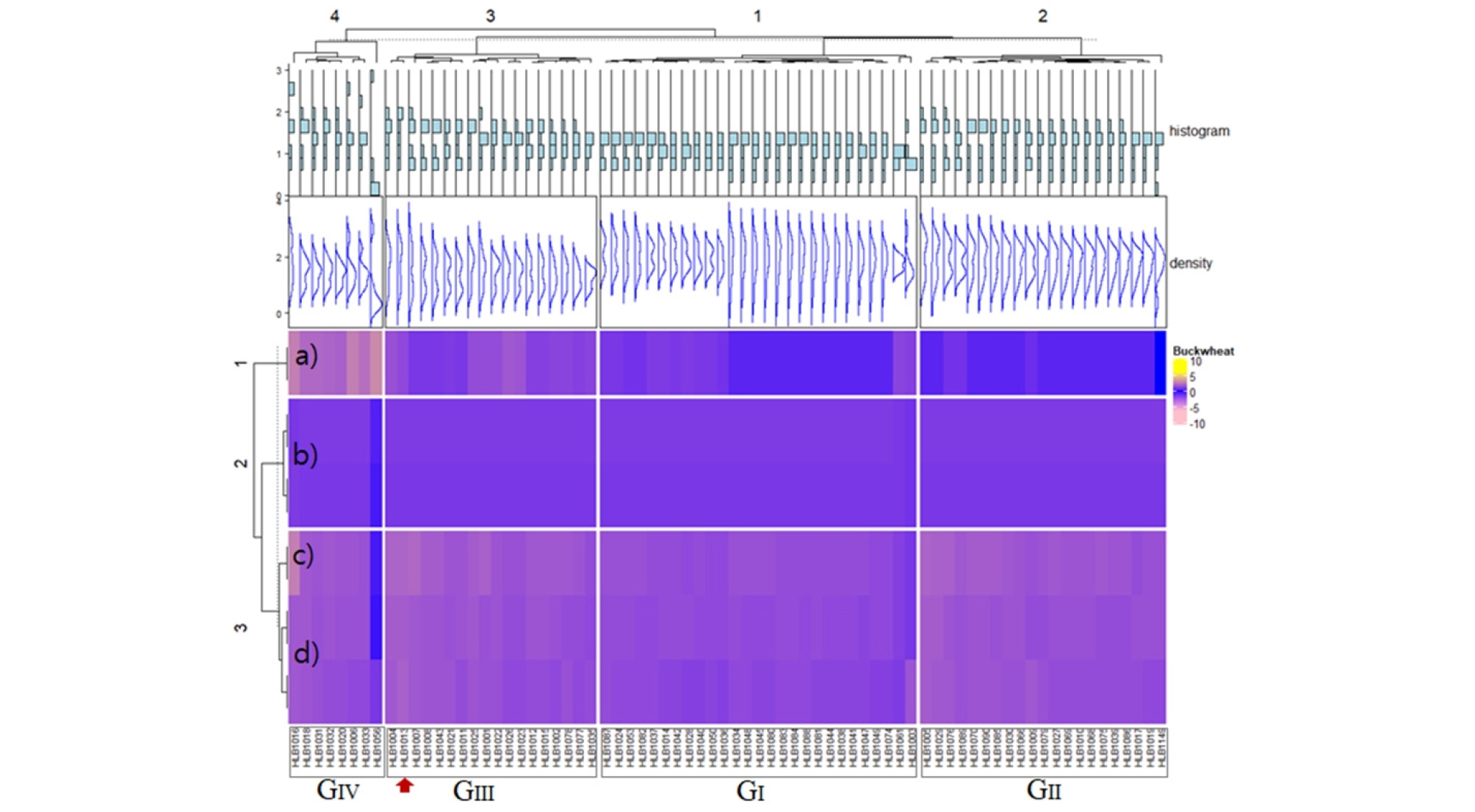
Fig. 8.
Heatmap representing differences in the chemotype of 74 tartary buckwheat germplasm. These data were standardized for chemotype of traits of a) quercetin, b) flavonoid, c) polyphenol, and d) rutin. Yellow or Pink indicates that the metabolite content is increased or decreased, respectively. Red arrow indicates the highest rutin accession.
쓴메밀 74개 유전자원을 대상으로 군집분석을 실시한 결과는 Fig. 9에 나타냈다. 종자길이, 종자폭, polyphenol, rutin, flavonoid, 총 5가지 변수를 이용하여 분석을 수행하였을 때 Semi-partial R squared 0.9을 기준으로 5개 군집으로 분류되었다. 제I군에는 종자화학형이 가장 낮은 HLB1051의 1개 자원이, 제II군에는 다른 군에 비해 종자화학형이 비교적 낮으면서 종자크기가 보통인 13개 자원이, 제III군에는 가장 많은 유전자원인 37개 자원이 해당되며, flavonoid와 rutin 함량은 중간정도이면서 종자크기가 작은 자원이, 제IV군은 rutin 함량은 보통이지만 종자크기가 큰 유시형인 HLB1012와 HLB1005의 2개 자원이 포함되었다. 끝으로 제V군에는 20개 자원이 속한 군집으로 rutin 함량이 가장 높았던 HLB1013 자원을 포함하여 화학형이 높고 종자길이가 짧은 자원들이 해당되었다. 이와 같은 군집분석 결과를 바탕으로 쓴메밀 유전자원을 구분하는 가장 중요한 형질은 종자화학형이며, 이 중에서 flavonoid와 rutin 비중이 높다는 것을 확인하였다.
유망 자원 선발
종자특성 및 유용성분 함량을 기반으로 선발한 유망 유전자원 정보는 Table 5에 나타냈다. 5개 자원(HLB1004, HLB1005, HLB1007, HLB1009, HLB1013)이 높은 rutin 함량(> 1,700 ㎎/100 g DW)을 보였으며, 2개 자원(HLB1056, HLB1061)은 매우 낮은 rutin 함량(<1,000 ㎎/100 g DW)을 나타냈다. Quercetin 함량에서는 1개 자원(HLB1056)이 높은 함량(> 0.3 ㎎/100 g DW)을 보였으나 31개 자원은 매우 낮은 quercetin 함량(< 0.05 ㎎/100 g DW)을 보였다. 쓴메밀 6개 자원(HLB1004, HLB1005, HLB1007, HLB1013, HLB1016, HLB1029)은 높은 flavonoid 함량(> 2000 ㎎/100 g DW)을 보였으나 2개 자원(HLB1003, HLB1056)은 flavonoid 함량이 낮았다. 또한, 5개 자원(HLB1004, HLB1005, HLB1013, HLB1025, HLB1029)은 polyphenol 함량이 1,700 ㎎/100 g DW 이상으로 높았으나 2개 자원(HLB1003, HLB1056)은 1,000 ㎎/100 g DW 이하의 낮은 함량을 보였다. 본 연구에서 선발된 rutin과 quercetin의 함량이 높은 유전자원은 고기능성 품종육성 연구에 유용하게 활용될 수 있을 것으로 기대된다.
Table 5.
Selected germplasm with the highest and lowest value of phenotype and chemotype traits
적 요
본 연구에서는 쓴메밀 74개 유전자원의 종자 표현형 및 화학형과 관련된 8개 주요형질을 평가하였으며, 그 결과를 바탕으로 주성분분석 및 군집분석을 수행하였다. 또한 rutin 고함유 자원 등 기능성 쓴메밀 육성재료로 활용가능한 유망 유전자원을 선발하였다. 쓴메밀 유전자원의 종자크기는 일반메밀보다 작은 평균 5.2 × 3.4 ㎜였으며, 종피색은 흑갈색이 45.9%로 가장 많았다. 종자모양은 달갈형과 타원형이 주를 이루었다. 쓴메밀 종자의 유용성분 평균 함량은 rutin이 1,393 ㎎/100 g DW였다. Flavonoid 함량 범위는 253-2,669 ㎎/100 g이었으며, polyphenol 함량 범위는 209-1,823 ㎎/100 g 으로 나타냈다. 쓴메밀 유전자원의 주성분 분석 결과, 제3주성분까지 적용하였을 때 전체 분산의 68.55%를 설명할 수 있었다. 제1주성분에는 rutin, flavonoid 및 polyphenol, 제2주성분에서는 종자길이, 제3주성분에서는 종자폭의 비중이 큰 것으로 나타났다. 이를 바탕으로 5개의 군집으로 구분할 수 있었으며, 유전자원을 구분하는 가장 중요한 형질로는 rutin, flavonoid 및 polyphenol이었다. 쓴메밀 유전자원 중 5개 자원(HLB1004, HLB1005, HLB1007, HLB1009, HLB1013)이 높은 rutin 함량을 보였으며, 이러한 유용자원들은 향후 기능성 육종소재 개발에 효과적으로 활용가능할 것으로 기대된다.



